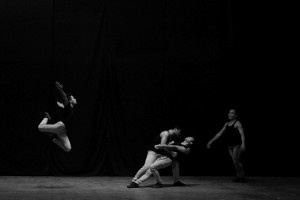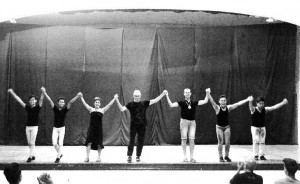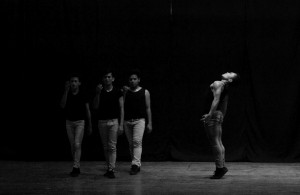
Blue Way – the trippy choreographic creation by French dance guru/choreographer Gigi Caciuleanu (with music by French-Cameroonian Manuel Wandji) which premiered on April 16 at the Bohol Cultural Center featuring Bohol Dance Project dancers Marvin Ablao, Jerrey David Aguilar, Jay Banquil, and Yassie Nalo – is a metaphysical study in contrasts and progressions set to motion by  the ebb and flow of sea/river waters —
For sure, Blue Way is not the usual dance performance you see live here in Bohol, even though contemporary dance (derived from postmodern dance) is one of the more popular dance genres, next perhaps to pop/street/hiphop, thanks to TV shows like So You Think You Can Dance. But like any art form done with passion and grace, Blue Way enthralls and more.
Taking off from the ideas of Merce Cunningham, the lead shaper of the modern/postmodern dance form, contemporary dance does not consider itself (a) narrative form of art. Blue Way fits the bill; even Mr. Caciuleanu’s précis isn’t really narrating.
“The sky is blue. But its blue contains the light of the sun, of the moon, of the stars; the lightness or the menacing madness of the clouds; all the colors of the rainbow. In the strange blue of the sky, there are moments of deep peace and tranquility, or place of turbulent explosions.” – Gigi Caciuleanu, Blue Way
Indeed, it is a “dance to be danced, not analyzed”.
Enjoying and appreciating contemporary dance performances as in all other performing arts transcends movement, music, effects, technique, ambiance, it is the whole experience, and more often than not, personal — on the audience — no longer the dancers’ nor the creators’. But the difference in po-mo/ contemporary dance is that its abstractions as in abstract paintings are purposive — a movement, a stroke, every nuance is in itself an expression, what it means is up to the viewer.
A fellow writer, after the April 15 Press Preview, said that the dance evoked romantic feelings in him. Another said, he felt sadness; perhaps reinforced by the “blue-ness” of the title and the lighting that flooded the dance floor (though, curious, that the blue light was absent in the actual premiere performance; the third performance had a rather awkward blue-sienna pallor, that, devoid of the black backdrop, created interesting shadow play). Yet another felt unsure and begged for some sort of explanation on the performance.
Mr. Caciuleanu (Mozart Steps, Imagine All The People, L’Om DAdA) indulged us and said it was his take on “moving along the waves, with it, in it, and finally, against it” using “movement that are mechanical/robotic but at the same time fluid” — likening that dynamic to the unpredictable yet measurable liquid movement of the river or the ocean, whose splashy soundscape you distinctly hear in between the timed breaks (or reset points) in the four-sectioned formulaic dance that very thinly recalls Trisha Brown’s postmodern Set and Reset.

Not so much the bodily movements, Blue Way’s are more contemporary, but the geometric space the dancers shape as they diagonally advance downstage in measured movement phrases, and as they vertically move through the stage with sustained lifts and syncopated jumps – patterns that flourish with each section of the dance in keeping with Manuel Wandji’s hypnotic Euro-North-African-fusion Berghain-esque minimalist euphony (Berghain is a stretch, but that’s just me) – harks the refracted geometries of the Trisha Brown classic.
A second (or third) viewing, unfortunately, does not promise to give more sense to your Blue Way viewing experience. Sure, you start seeing the patterns, appreciate the improved confidence in the dancers, notice the complexities of each dance phase and the nuanced movements unique to each dancer, but don’t expect to be enlightened story-wise. That is not the Blue Way.
 No matter, you will be charmed just the same.
No matter, you will be charmed just the same.
Blue Way is the feature presentation of this summer’s 2nd Bohol International Dance Workshop organized by Gardy Labad’s KasingSining in collaboration with the Provincial Government of Bohol, NCCA, US Embasy – Manila, Christophe Robin Colorist and Studio Harmonic. (By Liza V. Macalandag)
